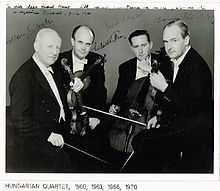Hungarian Quartet
The Hungarian String Quartet was a musical ensemble of world renown, particularly famous for its performances of quartets by Beethoven and Bartók. The quartet was founded in Budapest in 1935 (as the New Hungarian Quartet) and was disbanded in 1972.
Members
1st violin:
- Sándor Végh (1935–1937)
- Zoltán Székely (1937–1972)
2nd violin:
- Péter Szervánsky (1935–1937)
- Sándor Végh (1937–1940)
- Alexandre Moszkowsky (1940–1959)
- Mihaly Kuttner (1959–1972)
Viola:
- Denes Koromzay (1935–1972)
Cello:
- Pal Hermann (1935-1940)
- Vilmos Palotai (1940-c1956)
- Gabor (Gabriel) Magyar (c1956-1972)
Origins
The Quartet was originally brought together with Sándor Végh (a pupil of Jenő Hubay and Zoltán Kodály at Budapest Academy) as the first violin, but was set onto a balanced footing when the virtuoso violinist Zoltán Székely (graduate of the same Academy, as was Denes Koromzay (1913–2001)) was recruited in 1937. At that point Sándor Végh moved to the second violin desk, and in 1940 he left to found the Végh Quartet. He was then replaced by the Russian Alexandre Moszkowsky. The Quartet had made its debut in 1935, and met with swift success. Szekely was a friend of Béla Bartók, and the group became rapidly known by giving the Hungarian première performance of the Bartók 5th Quartet, which it studied with the composer. By 1938, the group had been heard in every major city of Western Europe.
During the war they were trapped in the Netherlands, and devoted the period to the intensive study of the Beethoven quartets, which were subsequently launched upon the world in the brilliant career which the group achieved after 1945. In 1950 they settled in the USA. In around 1956 the cello, and around 1960 the second violin desk, was reassigned, and in this new form the Quartet continued to maintain its busy programme of performance until 1972, while also undertaking teaching positions and the coaching of younger instrumentalists. In 1957, the newly configured Quartet performed in Boston for the Peabody Mason Concert series.[1]
In their second, 1966, recording of the Beethoven cycle, it is stated that Székely plays the 'Michelangelo' Stradivarius (1718), Kuttner plays the 'Santa Theresa' Petrus Guarnerius (1704), Koromzay plays a 1766 instrument by M. Decanet, and Magyar has a cello by Alessandro Gagliano of 1706.
This is actually the second of three Hungarian Quartets. The original Hungarian Quartet, also known as the Waldbauer-Kerpely Quartet, gave its first concert in 1910 playing Bartók and Kodály. The other members were Temesvary and Molnar. A later occupant of the viola chair was Kornstein who wrote an account of how the group practised for performance.
Recordings
(Examples)
- Schubert: Quartet in D minor 'Death and the Maiden D 810 (Nixa LP CLP 1152) (About 1952).[2]
- Schubert: Quartet in D minor 'Death and the Maiden' D 810 (Vox LP STPL 512.520).
- Schubert: Quartet in C major D 887 (Columbia CX 1566) (EMG review Sep 1958).
- Schubert: Quintet in A major D 667 'The Trout' with Louis Kentner, Georg Hörtnagel (Vox STPL 512.690).
- Schumann: Quintet in E flat major op 44, with George Solchany, piano. (Székely-Moszkowsky-Koromzay-Magyar) (Discophiles Français LP DF 730.030).
- Haydn: Quartets op 64 no 5; op 76 no 2. (Columbia LP CX 1527) (EMG review July 1958).
- Haydn: Quartets in D major op 65 no 5; in F major op 77 no 2. (Vox STPL 512.080).
- Mozart: Quartets in E flat major K 428; in A major K 464 (Columbia LP CX 1599). (Record News, Vol.7 No.1, lists as April 1959 release in UK).
- Mozart: Quartets in B flat major K 458; in C major K 475 (STPL 512.130).
- Tchaikovsky: Quartet no 1 in D major op 11 (Columbia LP CX 1581). (EMG review March 1959).
- Borodin: Quartet no 2 in D major (Columbia LP CX 1581). (EMG review March 1959).
- Kodály: Quartet no 2 in D major (Columbia LP CX 1614) (EMG review Jan 1959).
- Villa-Lobos: Quartet no 6 (Columbia LP CX 1614) (EMG review Jan 1959).
There are two complete cycles of the Beethoven quartets, both recorded in Paris:
- Mono 1953 set with the Székely-Moszkowsky-Koromzay-Palotai line-up.
- Stereo set (1960s) with the Székely-Kuttner-Koromzay-Magyar group. In UK this was issued on His Master's Voice in 1966 in the HQS series.
Sources
- E.M.G., The Art of Record Buying 1960 (EMG, London 1960).
- E. Sackville-West and D. Shawe-Taylor, The Record Year 2 (Collins, London 1953).
- R. Stowell, The Cambridge Companion to the String Quartet (Cambridge 2003).
- Hungarian Quartet, Beethoven Quartet recordings (HMV, Hayes 1966). (Sleevenotes.)
- Hungarian Quartet, Schubert D 810 recording (Vox, New York STPL 512.520). (Sleevenotes.)
- C. Kenneson, Székely and Bartok: the story of a friendship (Amadeus Publications 1994).
- Obituary of Koromzay
- Obituary of Székely
- Photo - Bartók with members of the Hungarian String Quartet (from left to right: Sándor Végh, László Halmos, Dénes Koromzay and Vilmos Palotai), 1935
- Buffalo Chamber Music Society checklist of dates
- Finding Aid for Gabriel Magyar Papers, 1953-2010
- The Cambridge Companion to the String Quartet, Cambridge Univ. Press, 2003, p. 65
- The New Grove Dictionary of Music, MacMillan, 1980, vol. 20, p. 157
- Cobbett's Cyclopedic Survey of Chamber Music, 2nd Ed., 1963, vol. II, pp. 251–253
